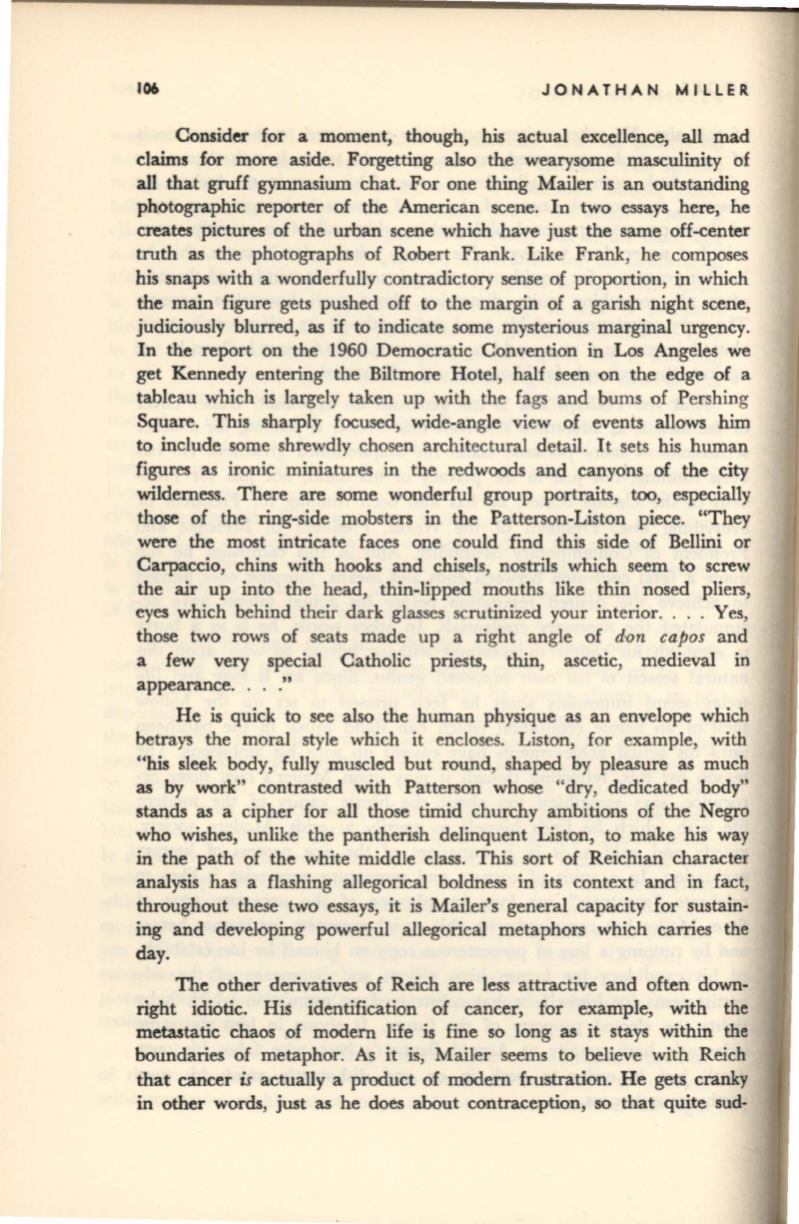
106
JONATHAN MILLER
Consider for a moment, though, his actual excellence, all mad
claims for more aside. Forgetting also the
weary~ome
masculinity of
all that
gruff
gymnasium chat. For one thing Mailer is an outstanding
photographic reporter of the American scene. In two essays here, he
creates pictures of the urban scene which have just the same off-center
truth as the photographs of Robert Frank. Like Frank, he composes
his snaps with a wonderfully contradictory sense of proportion, in which
the main figure gets pushed off to the margin of a garish night scene,
judiciously blurred, as
if
to indicate some mysterious marginal urgency.
In the report on the 1960 Democratic Convention in Los Angeles we
get Kennedy entering the Biltmore Hotel, half seen on the edge of a
tableau which is largely taken up with the fags and bums of Pershing
Square. This sharply focused, wide-angle view of events allows
him
to include some shrewdly chosen architectural detail. It sets his human
figures as ironic miniatures in the redwoods and canyons of the city
wilderness. There are some wonderful group portraits,
too,
especially
those of the ring-side mobsters in the Patterson-Liston piece. "They
were the most intricate faces one could find this side of Bellini or
Carpaccio, chins with hooks and chisels, nostrils which seem to screw
the air up into the head, thin-lipped mouths like thin nosed pliers,
eyes which behind their dark glasses scrutinized your interior... . Yes,
those two rows of seats made up a right angle of
don
capos
and
a few very special Catholic priests, thin, ascetic, medieval
in
appearance. . . ."
He is quick
to
see also the human physique as an envelope which
betrays the moral style which it encloses. Liston, for example, with
"his sleek body, fully muscled but round, shaped by pleasure as much
as by work" contrasted with Patterson whose "dry, dedicated body"
stands as a cipher for all those timid churchy ambitions of the Negro
who wishes, unlike the pantherish delinquent Liston, to make his way
in
the path of the white middle class. This sort of Reichian character
analysis has a flashing allegorical boldness in its context and in fact,
throughout these two essays, it is Mailer's general capacity for sustain–
ing and developing powerful allegorical metaphors which carries the
day.
The other derivatives of Reich are less attractive and often down–
right idiotic. His identification of cancer, for example, with the
metastatic chaos of modern life is fine so long as it stays within the
boundaries of metaphor. As it is, Mailer seems to believe with Reich
that cancer
is
actually a product of modern frustration. He gets cranky
in other words, just as he does about contraception, so that quite sud-


